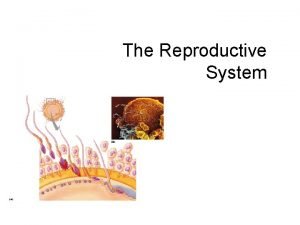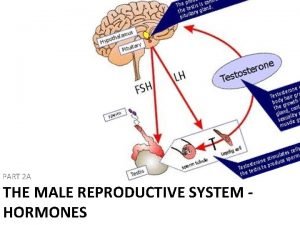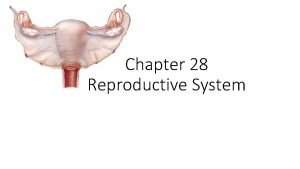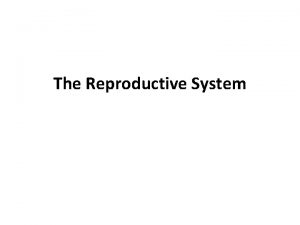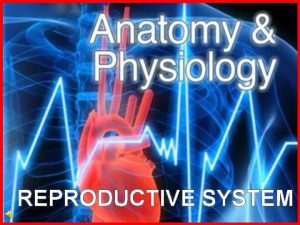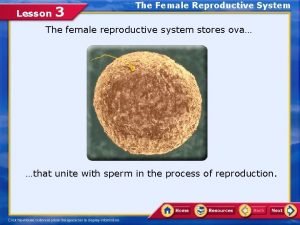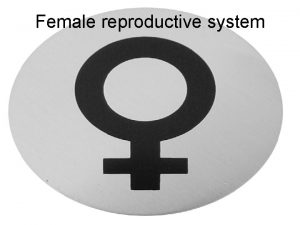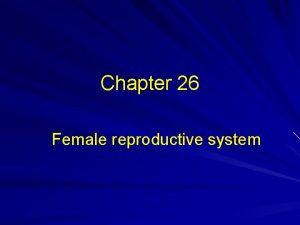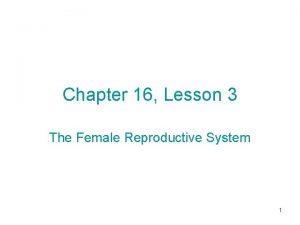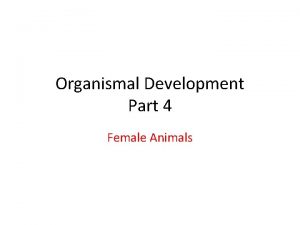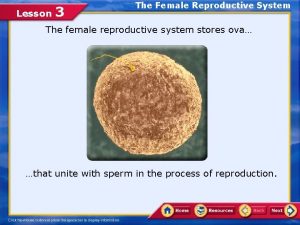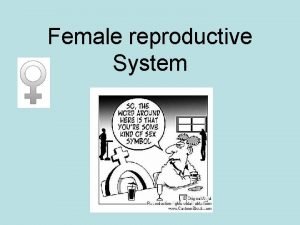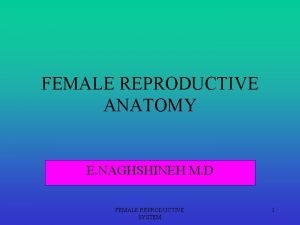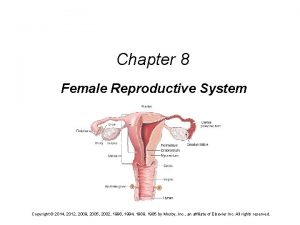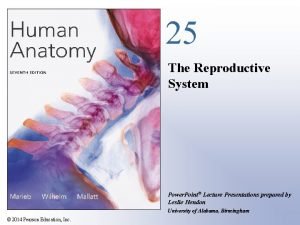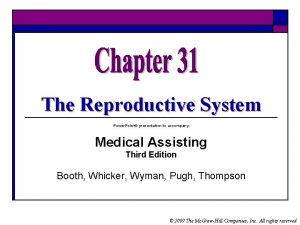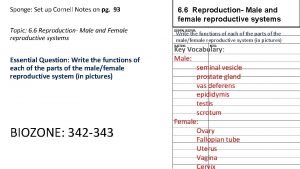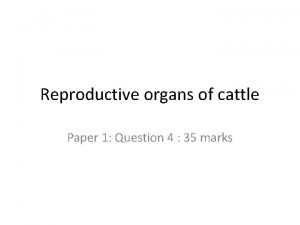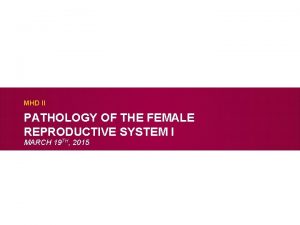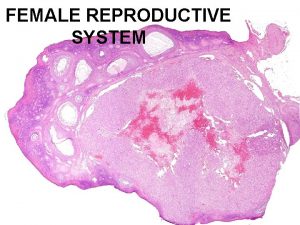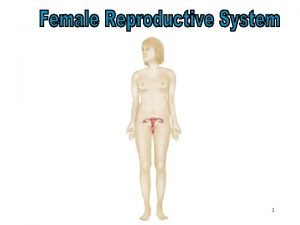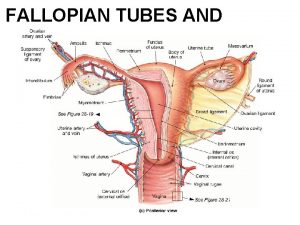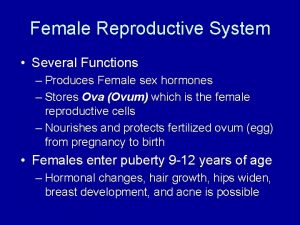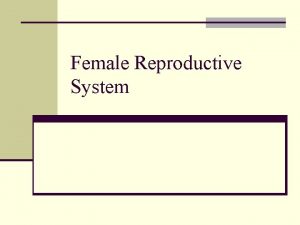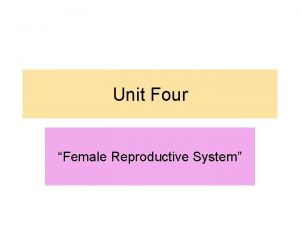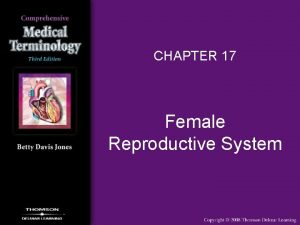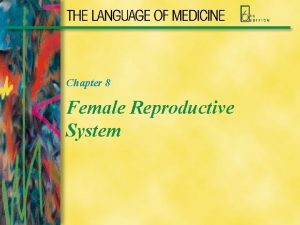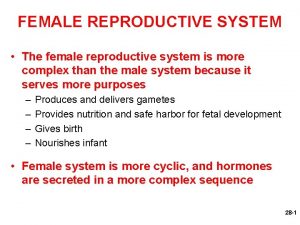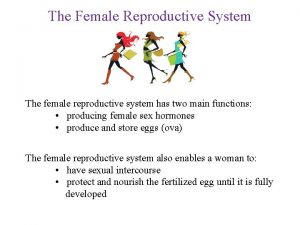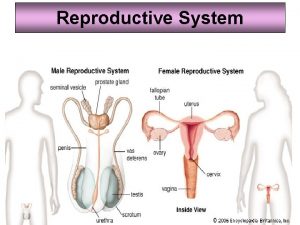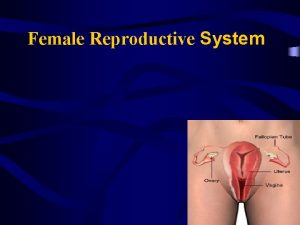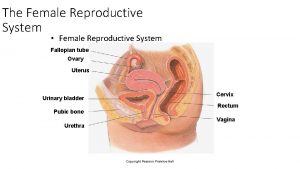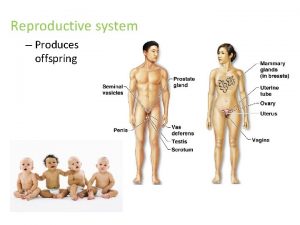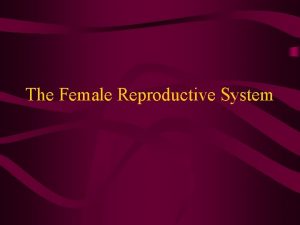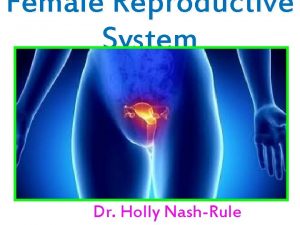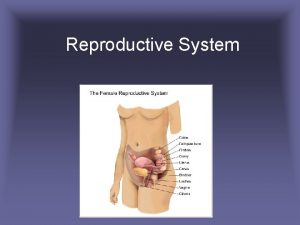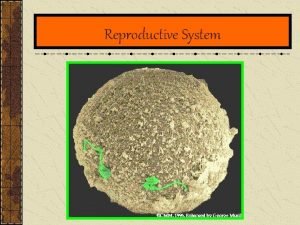The Female Reproductive System produces and maintains female









































- Slides: 41

______ The Female Reproductive System -____ produces and maintains female ___ sex ____, ____ them cells or ______, oocytes and transports to the ____ site of _____ fertilization -____ provides a ____ favorable environment _____ for the ______ development and _______ delivery of the ____ offspring -____ produces ______ female ___ sex ____ hormones Uterine (Fallopian) tube Ovary Uterus Urinary bladder Symphysis pubis Fimbriae Rectouterine pouch Fornix Cervix Rectum Vagina Urethra Clitoris Labium minus Labium majus Vaginal orifice Anus

The Female Reproductive System I. Ovaries -_______ primary ______ female ___ sex ______ organs -_______ develop in the _____ lower ____, abdomen _______ descend to ____ just ______ inferior to the _____ pelvic ____, brim _____ attach to the _____ lateral ______ pelvic Suspensory ligament (with ____, ______ wall ____ held in _____ place by the _____ broad ____, ligament the ovarian blood vessels _______, and the _____ ligament suspensory _______, ligament which also houses and nerves) ovarian blood ______ vessels and ______ nerves ______ Ovary Ovarian ligament Broad ligament

I. Ovaries -structure A. Tunica albuginea -_____ dense covering _______ layer of _____ connective _____ tissue B. Medulla -____ innermost _____ layer _______ housing _____ blood and ____ lymphatic ______ vessels and ______ nerves C. Cortex -_____ outer _____ layer _____ containing ______ masses of ____ cells called _______ ovarian _______, follicles each of which ______ include ___ one _______ primary ______; oocyte about _______ 400, 000 _______ primary _______ follicles at _______ puberty 1. Oogenesis -the _______ creation of ___, ova or ____ eggs Begins in early development, then stops, resumes at puberty Fertilization Ovum (egg) Secondary oocyte n 2 n=46 n=23 2 n=46 n Meiosis I Reduction division n Meiosis II Mitotic division n Primary oocyte n First polar body n Second polar bodies (die) Zygote

I. Ovaries C. Cortex 1. Oogenesis During synapsis of homologous chromosomes during Prophase I, crossing over occurs, resulting in new genetic variation

I. Ovaries C. Cortex 1. Oogenesis Rx – Genetic Disorder -______ chromosome ______, defects like those that _____ cause _____ Down _____, Syndrome are much _____ more _____ likely to _____ result from the egg ___, because each egg ___ is _______ decades ___, old and has had so much ____ time to be _______ exposed to ____, radiation viruses toxins that _____ cause _______ damage to _____ DNA ______, and ______ -_____ polar ____ body ______ biopsy can _____ allow a ______ couple to select _____ an ____ a ____ egg that does ___ not carry gene in ______whose women ____ genotype is ______ heterozygous for _______ genetic _______; disorder as in ________ hemophilia (____) XHXh or Duchenne Muscular Dystrophy XMXm or Sickle cell _______ Disease (___); S’S if ____ (_____) _____-___ chromosome with the _______-_______ disease causing gene the ______, which is ______ marked with _____ radioactivity or ______ fluorescence First polar Secondary is _______ detected in the ____ first _____ polar ____, body it ____ isn’t in the body oocyte ____ secondary ______, oocyte and that ____ secondary ______ oocyte is selected in vitro _____ fertilization _______ for ____

I. Ovaries C. Cortex 2. Follicle Maturation -______ during _______ prenatal ______, development each of the __ 1 _______ million _______ primary _______ oocytes is _____ surrounded by a _____ layer of ____ cells primordial ______ follicle called a _____ Primordial follicles

I. Ovaries C. Cortex onset of _______, 2. Follicle Maturation -at the _____ puberty _______Follicle _____ Stimulating ____ Hormone _______ released by the _______ anterior ____ pituitary _____ gland _____ stimulates the _______ 400, 000 _______ follicles to maturing in ______ groups of about begin ____ ___ 20 at a time Primordial follicles Primary oocyte Maturing follicle

I. Ovaries C. Cortex one of these _____ secondary _______ follicles 2. Follicle Maturation -____ outgrows the ______, others and, while the other _________, goes on to follicles degenerate ____ form a ______ mature ______ follicle Mature follicle

I. Ovaries C. Cortex 2. Follicle Maturation -the ____ maturing ____ dominant ______ follicle ____ fills with _____, fluid until, after 10 -14 days it _______ in diameter _______ reaches a ____ size of __ 1 cm and ______ of the ______ bulges out the wall ovary Theca externa Theca interna Granulosa cells Fluid-filled antrum Corona radiata Zona pellucida Secondary ooctye

I. Ovaries C. Cortex 2. Follicle Maturation -_____ processes of the ____ cells of the Corona ______ radiata ______ extend through the _____ layer of ______ called the Zona ____ glycoprotein ________ pellucida to provide nutrition for Theca externa secondary ______ oocyte the _____ Theca interna Granulosa cells Fluid-filled antrum Corona radiata Zona pellucida Secondary oocyte

I. Ovaries C. Cortex 3. Ovulation -finally _______ growing ____ fluid ____ pressure from within ______ the ______ waving follicle and _______ contact with the _______ infundibulum cause the fimbriae of the ______ follicle to _______, rupture ____ releasing the _____ secondary ______ oocyte and some of its ______ surrounding ____ cells cavity into the _____ body ______ Infundibulum -__ 1 of __ 5 women ______ will at some time _____ experience ____ called ______ pain mittelschmerz (_____) middle pain at the ____ moment of _____, ovulation usually _______ lasting from a _______ to a _____, but few minutes few hours days and lasting up to a few sometimes ______, alternating from ____ one ____ side to the _____ other _____ from month _____ to month ______ Secondary oocyte Ovary

I. Ovaries C. Cortex fimbriae of the 3. Ovulation -as ____ ovulation _____, nears the ___________ infundibulum become ____ engorged with _____, blood to _______ increase its _______ chances of _____ “catching” the ______ oocyte Corpus albicans Corpus luteum Fimbria Uterine tube Ovulation Primordial follicles Corona radiata Primary follicle Secondary follicle Zona pellucida Secondary oocyte Dominant follicle Mature (Graafian) follicle First polar body Infundibulum

I. Ovaries C. Cortex 4. Corpus luteum -_______ “yellow _____ body” ovulation _______ secrete _____ large -after ____, remains to _______ of ______, progesterone which amounts _____ stimulates the ______ endometrium in the _______ more vascular _______ uterine ______ lining to become favorable and glandular ____ to create _____ a ____ environment development ______ for ______of the _______, embryo if ______ fertilization takes place estrogen -_______ releases progesterone ______ and ____, which ____ together ______ inhibit the _______ release of _______-______ (____) Follicle Stimulating Hormone FSH and (___) LH _____ Luteinizing _____ Hormone gonadotropins and _______ prevent the (_______) development of more ____ follicles ______

I. Ovaries C. Cortex 5. Corpus albicans -the _______ remnant of the _______ Corpus ______ luteum after it _____ replaced with ____ scar degenerates and is _______, _____ tissue after _____ fertilization does not occur Corpus albicans

II. Uterine (Fallopian) Tube -_____ passagway for the _______ ovulated _____ secondary ______ oocyte _____ lying between the ______ ovaries and the ______ uterine _____ horns site of _____ fertilization -_____ lined with ____, cilia which ____ towards beat _______ the ______ uterus to _____ create a ______ current which draws theoocyte infundibulum _____ into the ______ contractions peristaltic _____ and along with ____ of the ____ wall of the ____, tube ______ propel the ______ oocyte and the _______ towards the embryo _______ Uterine horns Uterine tube ______ uterus Infundibulum

develops from a ____ III. Uterus -_______ receives the embryo ______ that ____ fertilized ___ and _______ egg sustains its ______ development implantation of the embryo -____ site of ______ forms ____ maternal portion pregnancy placenta during _____ -______ of ____ contracts menses and _____ delivery expel ______ fetus during ________ to _____ inner _____ A. Endometrium -_____ layer of _______ mucous _____ membranes response to _______ estrogen 1. Proliferative phase -_______ thickens in _______ secreted by _____ granulosa ____ cells of the _____ developing ______ follicle Uterine horns Uterine tube Infundibulum Fundis Body Endometrium Myometrium Perimetrium Cervix Cervical orifice

III. Uterus A. Endometrium 2. Secretory phase -_______ becomes _____ more vascular _______ and _____ glandular in ____ response to ______ progesterone _______ secreted by the ______ corpus ______ luteum secretes ____, glycogen _____, -____ produces and _______ lipids _____, electrolytes and _____ other ____ nutrients to ______ create an ______ environment ____ favorable for _____ embryonic ______ development Uterine horns Uterine tube Infundibulum Fundis Body Endometrium Myometrium Perimetrium Cervix Cervical orifice

III. Uterus A. Endometrium 3. Menstruation -if ______ corpus ______ luteum ______ ceases to _______, function the ______ concentrations of ______ progesterone and _______ drop causing _____ blood ______ vessels in estrogen ____, ______ endometrium to ____, constrict _____ restricting blood flow oxygen _____ dying ______ tissues _____ and ______; _____ disintegrate and ______ slough away, and, along with _____ from ______ broken _____, capillaries _____ create blood Uterine horns menstrual ____ flow Uterine tube ____ Infundibulum Fundis Body Endometrium Myometrium Perimetrium Cervix Cervical orifice

III. Uterus 3. Increased release of FSH stimulates a new follicle to develop. 5. The developing follicle secretes increasing levels of estrogen 1. Low concentration of estrogen and progesterone allow pituitary to become unhibited, increasing the release of FSH and LH. 7. Increased levels of estrogen stimulate proliferative phase in uterus, endometrium thickens Proliferative phase

III. Uterus 12. Hypothalamus stimulates pituitary to release LH, causing the follicle to rupture, triggering ovulation. 15. Increased levels of progesterone and estrogen released by corpus luteum after ovulation stimulate secretory phase in uterus, and inhibit secretion of FSH and LH by anterior pituitary gland 10. Increasing levels of progesterone and estrogen inhibit release of FSH and LH by pituitary. Proliferative phase Secretory phase

III. Uterus 24. Fertilization must take place during a 72 hour window between Day 12 -14. If it doesn’t, the corpus luteum begins to degenerate around Day 24 28. Degeneration of the corpus luteum causes decreases in estrogen and progesterone, leading to blood vessel constriction in the endometrium of the uterus Menstruation Proliferative phase Secretory phase 1. Low blood supply to tissues of endometrium cause tissues to die and slough away, leading to the formation of the menses

copulatory _____; IV. Vagina -______ female _____ organ receives _____ penis during ______ sexual _____ intercourse -_____ passageway for the ______ menses and other _____ secretions of the ______ uterus acts as the _____ birth _____ canal lying _______ -____ between the ______ cervix of the ______ uterus and the _____ vulva protected from ____ infection by the _____ mutualistic bacteria -____________ Lactobacillus ___, sp. which _______ ferment lactose produced by the ______ into _____ cells of the vagina lactic ____, acid ___ p. H = __ 5 Uterine horns Uterine tube Infundibulum Fundis Body Vagina Endometrium Myometrium Perimetrium Cervix Cervical orifice

____ and ______ IV. Vagina -_______ vaginal ______ orifice further protected closed ___ off by the ______, _____ with a ______ hymen a ____ thin membrane small central _________ opening to allow _______ uterine and vaginal secretions to _______; often cultural ________ pass outside indicator of ____ virginity erectile tissues outer _______ opening -______ houses _______ around its _____ which _______ respond to ______ sexual _____ stimulation by becoming ____ with _____, engorged blood causing the ______ vagina to _______ expand ____ elongate Mons pubis Clitoris Urethral orifice Vaginal orifice Perineum Anus Labium majus

female orgasm ______, ______ IV. Vagina-just _____ prior to ______ tissues of the _____ outer ______ become ____ third of vagina engorged with _____ blood to ____ increase _______ friction on the _____ penis and _______ male trigger ______ orgasm V. Vulva-_______ external ______ female ____ genitalia -____ structure which _____ surrounds _____ outer ____ openings of ____ both the _______ and the ______ urethra vagina A. Labium majus -______ larger ____ lips of the vulva _____ Clitoris Urethral orifice Vaginal orifice Perineum Anus Mons pubis Labium majus

V. Vulva protect the _____ other _______ external A. Labium majus -_______ enclose and ___________ reproductive ______ organs separated by ____ pudendal ____, cleft which includes -_______ the _______ urethral and _______ vaginal orifices pubic ____, hair -_______ covered on the _______ outside with _________ sebaceous ______, glands and ____ sweat apocrine ______, glands which ______ secrete ____ high _______ volumes of _____ sweat as part of the ______ sexual ____ response Pudendal cleft Clitoris Urethral orifice Vaginal orifice Perineum Anus Mons pubis Labium majus Vestibule Labium minus

V. Vulva B. Labium minus -_______, smaller _____ inner ____ lips of the _____ vulva merge _____ anteriorly -_______ enclose the ____ vestibule and ______ to form ____ a ______ hood-like ____ covering for the clitoris C. Clitoris -_____ structured ____ similarly to the _____, penis only __ 2 ___ cm long erectile _______ tissues that become ____ engorged -contains ______ with _____ blood in ____ response to ______ sexual _____ stimulation anterior ___, -has _____ glans on _______ end containing ______ highly ______ concentrated _____ nerve _______ endings enclosed by the _____ labia _______ minora containing D. Vestibule -_____ space ______ vaginal and _______ urethral _______ orifices Bartholin’s ______ glands ______ empty into -_____ vestibular (_____) ____ vestibule on either ____ side of the _______ vaginal ______, orifice _______ secreting mucus into _____ vestibule to provide _____ lubrication for ______ sexual ______ intercourse -contain _______ masses of _______ erectile _______ tissues on either side called _____ bulbs vestibular _____

VI. Mammary Glands -_______ similar in ______ males and _______, females _____ stimulated to ____ develop in ____ females by ____ estrogen ______ at the _____ secreted by ovaries onset of _______ puberty -each ______ breast _____ composed of ______ 15 -20 ______, lobes which _______ contain ____ alveolar _______ glands -____ alveolar _______ glands ______ empty into _____ alveolar ______, ducts which ______ drain into _____ lactiferous ______, ducts which _____ open to the _______ outside through the _______ nipple Pectoralis major Pectoralis minor Alveolar glands Alveolar duct Ampulla Lactiferous duct Areola Nipple Ampulla Alveolar duct

VI. Mammary Glands -during _______, puberty ______ glands and _____ ducts _______, enlarge become ______ surrounded with _______ adipose tissue pregnancy _____ placental _____, estrogen -during _____, progesterone and ____ lactogen _____ stimulate ______, _______ breasts to ____ develop _______, further ____ possibly _____ doubling in _____ size and _____ replacing _______ adipose _______ tissue with _____ glandular _______, tissue _____ milk Adipose tissue _____ production _____ stimulated by _____ prolactin is inhibited until after _____ birth by _____ high ______ levels _____ of _____ estrogen and ______ progesterone Pectoralis major Pectoralis minor Alveolar glands Alveolar duct Ampulla Lactiferous duct Areola Nipple Ampulla Alveolar duct

VI. Mammary Glands Rx – Breast Cancer -_____ most ____ common _______ cancer among _______ women after _____ skin _______, cancer with ____ 178, 000 ____ new ______ cases and _______ 40, 000 _______ deaths _____ each _____ year in the _____; U. S. __ 1 in ____ 13 _______ women in the _____ U. S. will get ______ breast ______ cancer some _____ time during their _____, life ______ North at ______ America has ____ highest _____ rate of ______ breast _______ cancer ____ in the ______, world ____ leading ______ cause of _______ cancer ______ death among ____, women _____ only ____ 1% of ______ breast ____ cancers are in _____ men Tumor

VI. Mammary Glands Rx – Breast Cancer -_______ 5 -10% _______ caused by an _____ inherited _____ tendency treated by ______ lumpectomy (____ removal of ______) tumor -_______ or ______ mastectomy (____ removal of ______) breast and _____ sometimes _______ accompanying ______ lymph ______, nodes _____ followed by _____ radiation and _______ chemotherapy -_____ prevented by ______ early _____, detection _______ breast _____self ______ exam and ______ yearly _______ mammograms for _______ women 40 _____ knowing _____ risk _______; factors ____, age ______ family over ___, history and _____ especially being _______ female (_______growth _______, _____ triggering _____) hormones Tumor

The Female Reproductive System http: //home. earthlink. net/~durangodave/html/writing/Rigby-Yoculan. htm Rx – Uterine Cancer -_____ most _____ common _______ cancer of the _______ female ______ reproductive _____, tract with about _______ 39, 000 ____ new ______ cases and _____ 7400 _______ deaths _____ each ____ year in the ____ U. S. -_____ most _______ uterine _______ cancers are ______ endometrial ______, carcinomas with _____ some _______ uterine _____ sarcomas (______ cancer of the ______) myometrium -_____ 84% ____ survival _____ rate -______ often _______ treated by ______ hysterectomy (____ surgical _____ excision of the ______), uterus often with ____ both _______ ovaries and _______ uterine ______, tubes _____ sometimes ______ accompanied radiation and _______ chemotherapy by ____ Rx – Amenorrhea/Oligomenorrhea -_____ complete _____ stoppage or _____ diminished In 1968 15 year-old Cathy Rigby became the _____ menstrual _____ flow ____ due to ____ reduced first American gymnast to medal in _____ estrogen _______ levels international competition. In “a sport that demands absolute control, both emotionally more ____ common to _____ elite _______ female -______ and physically”, she also suffered from an athletes with ____ low _____ body ____ fat ____ eating disorder.

http: //www. usatoday. com/news/health/2006 -02 -05 -women-health-cover_x. htm Rx – Amenorrhea/Oligomenorrhea -_______ higher _______ levels of ____ estrogen _____ stimulates _______ greater _____ deposition of ____ fat in _______, breasts ______, thighs ____, buttocks and ______ under _____ skin higher _____ percentage _____ body ____ fat in -_______ women _____ contains ______ calorie _______ reserve _________ required to _______ sustain a _____ pregnancy -______ diminished ____ fat ____ reserves ______ result in _____ decreased _____ secretion of the _____ hormone ______ leptin by _______ adipose ____, cells which _____ leads to _____ decreased _______ secretion Follicle Stimulating _____ Hormone of _______-______ Olympic diver and Bulimia nervosa sufferer by the ____ anterior ____, pituitary ____ leading Kumiko Soldati. "It would be hard to find a to _____ decreased ____ follicle ______ development female athlete in the aesthetic sports — gymnastics, diving, cheerleading, figure and ____ decreased ____ estrogen _____, production skating, dancing — who isn't preoccupied leading to _____ decreased _____ thickening ____ with body image and somewhat obsessive about what she is eating”. endometrium during _____ proliferative of ______ phase in _______ uterus

http: //www. maryelise. com/modernwoman_eatingdisorder_models. JPG Rx – Amenorrhea/Oligomenorrhea -can also be _______ caused by _______ eating _____, disorders _____ especially _____ Anorexia ____ nervosa Very thin fashion models portrayed by media as “what it is to be sexy”, ironically more likely to be “sexless” due to decreased libido linked to diminished estrogen secretion because of decreased fat reserves

Rx – Ovarian Cancer -_____ 9 th most common ______ cancer among ______, women ___5 th ______ ______, leading cause of cancer death among women causing ______ new _____ cases each ____ 22, 000 ____ year in the ____, U. S. and ______ 15, 000 ______ deaths per ____ year in the ____ U. S. -____ risk ______ factors include age ___ (____ 67% of _______ ovarian ______ cancers ______ over ___), occur in women 55 ______, obesity and ______ family ______ history (__ 1 in ___ 10 _______ ovarian _______ cancers ______ linked to a _______ change in _______ genetics that can be _____ tested for) -______ treated most _____ often with _______ surgical _______ excision (______) ___ or both _______ oophorectomy in which one ovaries are ____, _____ removed sometimes _____ along with the ______ uterine tubes uterus followed by ______ chemotherapy and the ______, -__ 9 out of ___ 10 women ______ treated for _____ early _______ ovarian ______ cancer will ____ live more than ____ five _____ years after ____, detection but _____ early _____ detection is ____, difficult because symptoms _____ are ______ vague

Rx – Premenstrual Syndrome (PMS) -affects ____ 80% (____) 40 million of ____ American women sometime during Hysterectomy -the surgical removal of the uterus their ____ 400 or so ____ menstrual cycles Hysterics -a fit of uncontrollable laughter or crying -affects only ____ ovulating women, not Hysteria -from the former notion that hysterical _______ pregnant or post-menopausal women were suffering from disturbances ____ of the womb women -thought to be caused by _____ imperfect _____ ovulation causing _____ imbalance of ____ estrogen and ______; progesterone too much ____ estrogen or too little progesterone ______ -thought to _____, cause and be ______ caused by ____ decreased amounts of the ____ inhibitory _______ neurotransmitter ____, serotonin which causes the _____ limbic ______ system to become uninhibited causing a woman to _____, feel too much _______ emotion “______”

Rx – Premenstrual Syndrome (PMS) -____ physical symptoms include ____, headache ____, joint pain _____ fluid ____, _____, abdominal ____ retention constipation ______, cramps ______, fatigue ____, backache _____ heart _____, palpitations and _____ weight gain -______ psychological symptoms include _____, irritability _____, depression ______, anxiety panic attacks ______, tension ____ lack of ___________, coordination decreased _____ libido -_____ post-partum _____ depression is a much ______ deeper form of ____ PMS linked to ____ hormone changes after _______ delivery -______ treated with ______ modifications to ____ diet (____ high in ____, fiber ___ low in ___, salt ______, sugars _______, starches ____, fats _______, caffeine and ______), alcohol _______ exercise (_______ increase _____ releaseof _____), endorphins _____ tranquilizers http: //www. kartoen. be/cartoons/happysad/pms. gif progesterone therapy like Valium ______, ______

The Reproductive Systems Rx – Sexually Transmitted Diseases 1. Chlamydia -caused by the bacterium ______________ Chlamydia trachomatis -_____ transmitted by ______, vaginal ____, anal or ____ oral ___, sex can be _____ transmitted to an ______ unborn ____ baby from its _______ infected ______ mother during _____ pregnancy infects an estimated _____ 2. 8 million in the ____ U. S. each -______ year but only _____ 0. 9 million _____ cases are _______ reported ____, -____ 75% of ______ women and ____ 50% of ____ men _______ infected show __ no _____, symptoms ______ appear in ___ 1 -3 ______ weeks after ____ exposure -_____ symptoms include _______ burning _____ sensation during ____ urination and ____ abnormal ____ discharge from _____ penis or ______, vagina leads to ______ pelvic ______ inflammatory _______ disease (___) ____ of PID in ______ women when left ____ untreated in 40% cases can lead to sterility _____, ______ -______ treated with _____ antibiotics

Rx – Sexually Transmitted Diseases 2. Gonorrhea -______ caused by _____ bacterium __________ Neisseria gonorrhoeae -_______ 700, 000 ____ new _____ cases each ____ year in the ____ U. S. with about ____ half being ____ reported -_____ transmitted by ______ contact with _____, penis ______, vagina ______, mouth or ____ anus of _______ infected ______, person and from a ______ mother to her ____ baby as it ______ passes through the _____ birth _____ canal -_____ symptoms in ____ men include _______ burning ____ sensation while ____, urinating ____ discharge (___) pus from the _______, urethra and painful and _______ swollen ____ testicles ______ -________ symptoms in ______ women may include burning sensation while ____, urinating increased ______ vaginal ____, discharge and ________ periods ______, but most ____ bleeding between menstrual women show __ no _____, symptoms or _____ symptoms are ____non ______ specific and ____ mistaken for _____ something ____ else _______ -can lead to ____ PID and _______ sterility in ______ women treated with _____, antibiotics which is getting more -______ difficult due to the emergence of drug-resistant strains

Rx – Sexually Transmitted Diseases 3. Genital Herpes -caused by the Herpes ______ Simplex _______ __ II _____ virus -_____ 45 million people (____) 20% in the ____ U. S. over age __ have been _______, ______ 12 infected more common in women than in ____ men -_____ transmitted by ______ sexual _______, contact only ______ rarely from _______ infected ______ mother to ______ unborn ____, baby but Blister-like Herpes lesions ____ infection can be ______ deadly to ____ baby -_____ symptoms include _____, fever _______ swollen ______ lymph _____, nodes and other _______ flu-like _____, symptoms and the ____ recurrent _____ appearance of ______ painful ______ genital ______ lesions -___ not necessarily prevented ____ through use of Classic Symptoms in Men _______, condom which may ___ not _____ cover all _____ infectious _____ areas -__ no ____, cure ______ treated with ____, Acyclovir which _______ prevents replication of _____ viral _____ DNA and ____ shortens the _____ lytic (_____) active _____ phase ____ Classic Symptoms in Women http: //www. famvir. com/info/toolsprivate/resources/photos. jsp

Rx – Sexually Transmitted Diseases 4. Genital Warts -______ caused by the ______ Human _____ Papilloma _____ Virus (____) HPV -about _____ 20 million currently _______ infected in the ____, U. S. with about _____ 6. 2 million ____ new _____ cases each ____, year ____ 50% of all _______ sexually _____ active ______ adults have had ____ infection at some point, by ___ age ___, 50 ____ 80% of all women in the ____ U. S. will have had an ____ infection ______ -_____ symptoms include _____ warts __ on or ______ around the ______ genital _____, area but ____ most _______ infected ______ people ____ show ___ no _____ symptoms and _____ don’t _____ know they have it Penile Genital Warts -_____ warts can be _______ removed _____ surgically or _____ chemically -can sometimes _______ increase risk ___ of _______ cervical ______ cancer -can be _____ prevented by _____ vaccination of ____, Gardasil® which _______ protects against the ____ four _____ types of HPV cause ____ 70% of ____ cervical _______ cancers and which _____ 90% of ______ genital _____ warts ____ http: //herpes-coldsores. com/std/genital_warts_pictures. htm#Penile%20 Genital%20 Herpes%20(HPV)%20 Pictures

Rx – Sexually Transmitted Diseases 5. Syphilis -______ caused by the bacterium _____________ Treponema pallidum -_____ transmitted by ______ contact with ____ open ____ sore called _______ chancre -_____ easily ______ treated with _____, antibiotics if ____ left ____ untreated ____ to secondary ____ and ______ progresses tertiary ______ syphilis _____ punctuated by ____ long _______ intervals of ______, latency ____ followed by ____ formation of ______ organs _____, ____ lesions called _______ gummas on the internal including brain and nerves leading to ____ dementia and _____ death the _____, _______ -thought to have been the _____ cause of _____ death of King Henry VIII six _____ wives and _____ many _____ lovers ____, who had ___ King Henry VIII 6. AIDS-____ Acquired ________ Immunodeficiency _____, Syndrome ______ caused by the ______ Human ________ Immunodeficiency _____ Virus (___) HIV -__ 2 to __ 5 _____ times _____ more ______ likely to ______ acquire _____ AIDS if _______ infected with _______ another ____, STD ______ lesions _______ provide ______ portals of _____ entry for ____, ____ draw ____ HIV infections HIV ____ host _____ cells (______ lymphocytes and ______) macrophages to ____ genitalia to _____ fight off ____ infection -has ______ caused ____ 1 million cases ____ in ____, U. S. ____ over ____ half have ____ died
 Where is the sperm stored
Where is the sperm stored Ovary duct
Ovary duct Drawing of the male and female reproductive system
Drawing of the male and female reproductive system Male fallopian tube
Male fallopian tube Differences between male and female reproductive organ
Differences between male and female reproductive organ Oviduct funnel
Oviduct funnel Figure 16-1 is a sagittal view of the male reproductive
Figure 16-1 is a sagittal view of the male reproductive What are primary sexual characteristics
What are primary sexual characteristics 90/2
90/2 Uterine orifice
Uterine orifice Bony vs cartilaginous fish
Bony vs cartilaginous fish Fetus reproductive system
Fetus reproductive system Female reproductive system
Female reproductive system Epilization
Epilization Lesson 3 the female reproductive system
Lesson 3 the female reproductive system Ovary diagram
Ovary diagram Female dog
Female dog Uterus is the part of which system in pila...?
Uterus is the part of which system in pila...? Pig reproductive anatomy
Pig reproductive anatomy Figure 28-1 the male reproductive system
Figure 28-1 the male reproductive system Infindibulum
Infindibulum Chapter 16 the reproductive system answer key
Chapter 16 the reproductive system answer key Female cow reproductive system
Female cow reproductive system Rabbit reproductive system female
Rabbit reproductive system female Diaphragm of the female reproductive system
Diaphragm of the female reproductive system Oogonium
Oogonium Lesson 3 the female reproductive system
Lesson 3 the female reproductive system Color of female reproductive system
Color of female reproductive system Female reproductive system external
Female reproductive system external Chapter 8 female reproductive system
Chapter 8 female reproductive system Conclusion of female reproductive system
Conclusion of female reproductive system Diaphragm of the female reproductive system
Diaphragm of the female reproductive system Female reproductive system pathology
Female reproductive system pathology Female reproductive system label
Female reproductive system label Cow reproductive anatomy
Cow reproductive anatomy Female reproductive system pathology
Female reproductive system pathology Female reproductive system pathology
Female reproductive system pathology Female reproductive system
Female reproductive system Hysterosalpingoophorectomy
Hysterosalpingoophorectomy Female reproductive system pathology
Female reproductive system pathology Bovine female reproductive system
Bovine female reproductive system Female reproductive system anatomy
Female reproductive system anatomy




